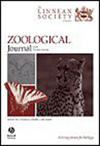New information on the anatomically derived millerettid Milleretta rubidgei from the latest Permian based on µCT data
IF 2.8
2区 生物学
Q1 ZOOLOGY
引用次数: 0
Abstract
The fossil reptile Milleretta holds a prominent role in phylogenetic analyses of early reptile relationships. It has often been used as the sole marker for the anatomically diverse middle to late Permian Millerettidae, a clade that has been hypothesized as the earliest diverging parareptiles and therefore only distantly related to the reptile crown group. However, the anatomy of Milleretta remains incompletely documented, presenting an obstacle to phylogenetic studies of early reptile evolution. We re-examine the cranial anatomy of Milleretta rubidgei using synchrotron micro-computed tomography of two specimens, representing a juvenile and a subadult. These immature individuals have clearly visible sutures, differing from osteologically mature individuals, in which cranial osteoderms obscure the cranial anatomy, particularly in the antorbital region. We demonstrate that Milleretta and other millerettids share many derived similarities with Neodiapsida (a derived clade that includes the reptile crown group), particularly of the neurocranium and palatoquadrate. Comparison with other millerettids reveals that some features seen in adult specimens of Milleretta are, in fact, derived features, resulting from secondary modification in osteologically mature individuals. These observations suggest that Milleretta is an anatomically derived millerettid and urge caution in using this taxon as the semaphorant of this disparate group of stem reptiles.基于微CT数据的最新二叠纪解剖衍生的millerettid Milleretta rubidgei新信息
爬行动物化石Milleretta在早期爬行动物关系的系统发育分析中起着重要作用。它经常被用来作为解剖学上多样化的二叠纪中晚期千孔虫科的唯一标志,千孔虫科被假设为最早分化的副喙类,因此与爬行动物冠类只有远亲关系。然而,Milleretta的解剖结构仍然不完整,这对早期爬行动物进化的系统发育研究构成了障碍。我们使用同步加速器微型计算机断层扫描重新检查了两个标本的颅骨解剖,分别代表了一个少年和一个亚成年。这些未成熟的个体有清晰可见的缝合线,不同于骨学成熟的个体,后者颅骨骨皮掩盖了颅骨解剖结构,特别是在眶前区域。我们证明了千禧年目和其他千禧年目与新底亚目(包括爬行动物冠类的派生分支)有许多相似之处,特别是在神经头盖骨和腭方动物方面。与其他千足虫的比较表明,在千足虫的成年标本中看到的一些特征实际上是衍生的特征,是由骨学成熟个体的二次修饰引起的。这些观察结果表明Milleretta是一个解剖学衍生的millerettid,并敦促谨慎使用这个分类群作为这个不同的茎类爬行动物群体的信号。
本文章由计算机程序翻译,如有差异,请以英文原文为准。
求助全文
约1分钟内获得全文
求助全文
来源期刊
CiteScore
6.50
自引率
10.70%
发文量
116
审稿时长
6-12 weeks
期刊介绍:
The Zoological Journal of the Linnean Society publishes papers on systematic and evolutionary zoology and comparative, functional and other studies where relevant to these areas. Studies of extinct as well as living animals are included. Reviews are also published; these may be invited by the Editorial Board, but uninvited reviews may also be considered. The Zoological Journal also has a wide circulation amongst zoologists and although narrowly specialized papers are not excluded, potential authors should bear that readership in mind.

 求助内容:
求助内容: 应助结果提醒方式:
应助结果提醒方式:


